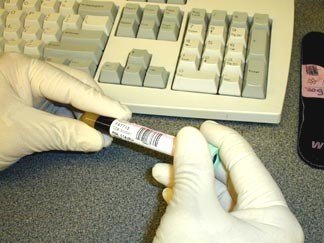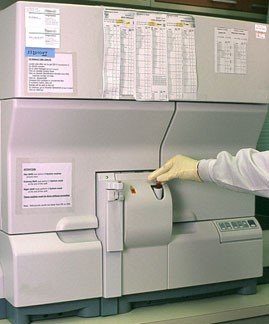Ever wonder what happens to your blood sample once it's been collected? It's sent "to the
lab" for analysis, but what does that entail? This article will take you on a tour as a
blood sample is processed.
In the laboratory, trained laboratorians use various
methods to analyze your sample as determined by what types of tests you need performed.
The Who's Who in the Lab article introduces you to these lab personnel.
For every
test, there is an appropriate sample that provides the best information for that test.
The Steps
Collecting Blood
Depending on the facility where you have your blood drawn, a
doctor, nurse or other laboratorian or another medical professional will draw your
blood. In this picture, a phlebotomist has inserted a needle into a vein on the
outer portion of the arm near the elbow.
When multiple tests are ordered, more
than one tube of blood may be collected & there is a specific order in which
different collection tubes with special preservatives must be drawn.
Labeling Collected Samples
Once the blood is drawn, the tube is labeled. In many labs, the
label may be pre-printed with the patient's name and unique patient identification
number, or a barcoded label carrying this information is used.
It is essential
that the person drawing the sample label the tube properly before leaving your side.
Documentation
After the sample has been collected and labeled, it is transported
to the lab to be logged in. Depending on the test needed & where you have the sample
drawn, your blood may be simply transported to the lab where the analysis is
performed or transported to a lab that specializes in a particular blood analysis.
Once the specimen arrives in the lab, your blood sample will be logged into the
laboratory's tracking system. The tube label contains all the information necessary
to ensure that the sample is analyzed for the appropriate tests and the results are
matched to your name. Usually, a written or electronic requisition form listing not
only your information but also your health practitioner's name and address is sent
with the sample so the results can be sent to the appropriate person.
Processing
Depending upon the tests that have been ordered, your blood sample
may be processed before it is analyzed. Most routine laboratory tests are performed
on either plasma or serum. Plasma is the liquid portion of blood. It is separated
from the cellular portion of blood by rapidly spinning the specimen in a centrifuge
for several minutes. The plasma, which has a light yellow color, appears at the top
of the tube, while the blood cells are at the bottom.
Serum is plasma that has
been allowed to clot. It is prepared in the same way as plasma; however, the blood
is collected into a tube with no anticoagulant. While spinning in the centrifuge,
the clot moves with the cells to the bottom of the blood collection tube, leaving
the serum on top.
If the test requires whole blood (e.g., a complete blood
count), the sample can be analyzed directly without further processing.
Testing (Automated)
In most cases, an instrument, appropriately called a blood
analyzer, analyzes the blood sample. In this picture, the tube of blood is being
placed directly into the machine. This particular state-of-the-art analyzer is
capable of running batches of samples - up to 120 samples per hour. In general,
chemistry analyzers use serum and/or plasma, and hematology and coagulation
analyzers use blood that contains an anticoagulant to prevent clotting.
Results
With the latest technology in analyzers comes the ability to
generate the results electronically & graphically. In this case, the results will be
sent electronically to the health practitioner. If the results indicate that the
patient may be very ill, the laboratory may call the health practitioner with the
results & then send the written or electronic report.
The length of time
between the drawing of the blood & when the health practitioner gets the results can
vary greatly, from as little as a few minutes to as much as several weeks. Urgency,
geographic distances, processing schedules, complexity of the test and other factors
contribute to the length of time required before results are available to the health
practitioner, who will then share the results with you, the patient.












